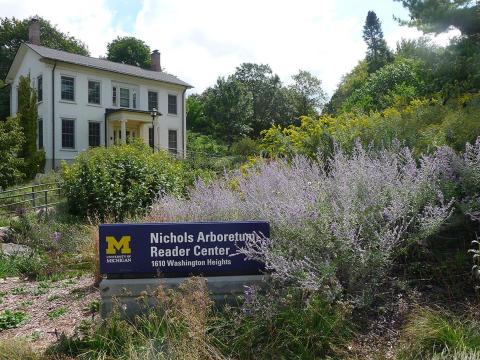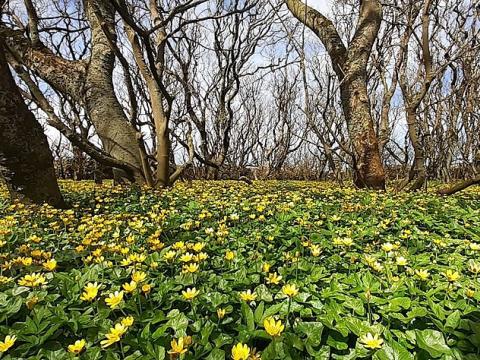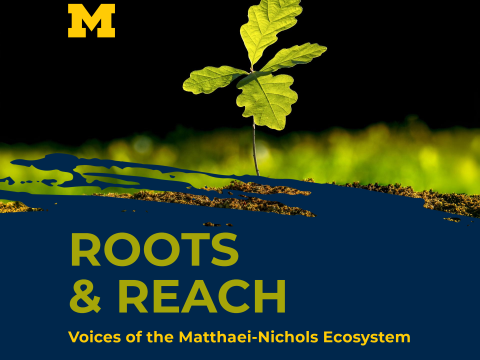At Matthaei Botanical Gardens and Nichols Arboretum, our mission is rooted in ecological resilience. We focus on sustainability, climate-forward practices, and biocultural diversity. One species that perfectly encapsulates our efforts is the Eastern Massasauga rattlesnake.
This small, thick-bodied rattlesnake, with its distinctive black bow-tie markings, plays a crucial role in Michigan’s ecosystems. As a keystone species, the Eastern Massasauga helps regulate populations of small mammals, such as meadow voles, which are hosts for ticks. By controlling vole populations, the rattlesnake indirectly helps manage the tick population and maintain ecosystem balance.
Despite their importance, Eastern Massasaugas are threatened by habitat loss, degradation, and fragmentation. Urban development since the 1970s has significantly reduced their numbers, with roads proving particularly fatal.
At MBGNA, we are committed to restoring and protecting the habitats these snakes and other wildlife depend on. One of our primary strategies involves comprehensive habitat restoration.
Habitat Restoration: A Multifaceted Approach
Our habitat restoration efforts span all seasons, each with specific tasks critical for ecosystem health. Early each spring, we conduct prescribed burns to manage invasive species and promote the growth of native vegetation. This controlled use of fire might seem counterintuitive, but it is instrumental in maintaining Michigan's open habitats, which are crucial for the Eastern Massasauga's survival. Timing is critical; burns are conducted when temperatures are below 50 degrees to ensure the snakes are safely hibernating in burrows.
Our restoration work continues through the summer and fall. Summer interns are trained in identifying and controlling invasive plants, which, if left unchecked, can quickly alter the landscape that the rattlesnake needs to thrive. This hands-on experience for our interns extends to planting thousands of native species each year, helping to re-establish thriving ecosystems that benefit not just the Massasaugas, but a wide array of biodiversity. By fall, we shift our focus to collecting seeds from native prairie and woodland species. These seeds are propagated in our greenhouses and planted the following spring, creating a continuous cycle of restoration and growth.
Winter presents a unique opportunity to tackle invasive shrubs. With the soil frozen, we can access sensitive wetland areas with minimal disturbance, using brush cutters and chainsaws to remove invasive species that threaten native plants and animals.
In addition to our seasonal work, we've partnered with the US Fish and Wildlife Service to clear invasive species, particularly common and glossy buckthorn, from areas near Cummings Fen and along Fleming Creek. This project aims to create 30 acres of open fen and wet meadow habitats. The removal of invasive shrubs, re-seeding with native plants, and conducting prescribed burns are all part of our comprehensive restoration plan.
Integrating Modern Technology
Technology offers promising new tools for ecological management. We use advanced mapping programs to monitor invasive species and track restoration efforts. These digital maps can be shared with our teams, making it easier to coordinate and execute our strategies more efficiently.
In erosion control, we have moved away from the use of nylon mesh blankets—which can fatally entangle snakes—and instead use natural fiber products that biodegrade after a couple of years, providing a safer environment for wildlife.
The Unexpected Guardian: Beavers
Interestingly, our stewardship has welcomed a new ally—beavers. Last fall, a beaver established itself on our grounds, creating wetland habitats that benefit the Eastern Massasauga. Beavers naturally dam creeks and rivers, expanding wetland areas and enriching the biodiversity of the ecosystems we care for.
The presence of beavers in our restoration areas has had significant positive impacts. By building dams, beavers create wetlands that increase water retention in ecosystems. These new habitats support a variety of species, including amphibians, birds, and aquatic plants. For the Eastern Massasauga, the expanded wetland areas provide vital basking and foraging habitats, further supporting their survival. Additionally, the slow-moving waters created by beaver activity help reduce soil erosion and improve water quality, contributing to a healthier and more resilient ecosystem overall.
Join Us in Conservation
Community involvement is a cornerstone of our mission. We host regular volunteer workdays where Michigan students and the public can participate in our eco-restoration efforts. If you are passionate about environmental conservation, we invite you to join us - your participation can help ensure that species like the Eastern Massasauga rattlesnake and their ecosystems continue to thrive for generations to come!




